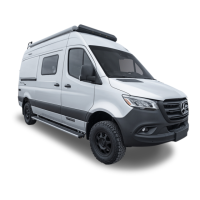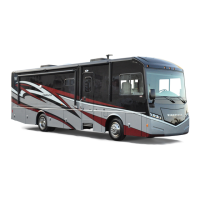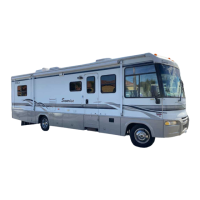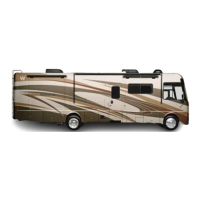Do you have a question about the Winnebago SOLIS 2020 and is the answer not in the manual?
Operator's manual details proper care and operation of the vehicle and equipment.
Explains danger, warning, caution, notice terms used to alert to hazards.
Recommendation for checking and adjusting front suspension and steering alignment.
Guidance on checking and adjusting headlight alignment after loading the vehicle.
Information on obtaining dealer assistance for information, service, and warranty repairs.
Procedure for reporting vehicle defects that could cause a crash or injury to NHTSA.
Details on labels affixed to the driver's door jamb regarding carrying capacity.
Explanation of data on the vehicle certification label, including VIN and model information.
Table detailing feature numbers, dimensions, capacities, and weight ratings for different models.
Section for recording owner details, vehicle information, and dealer/service center contacts.
General safety guidelines for occupants, seat belts, child restraints, and vehicle movement.
Precautions and recommendations for safe driving, including seat adjustment and road conditions.
DANGER warning regarding refueling motor fuel tanks and propane containers.
Warnings about propane gas, including filling containers, placing cylinders, and handling leaks.
Avoid inhaling exhaust gases; proper maintenance of exhaust and ventilation systems.
Procedures for responding to propane gas leaks and safety precautions for testing.
Information on the propane gas leak detector, its power connection, and replacement.
Details on the CO alarm, its testing, and replacement recommendations.
Information on the smoke alarm, its testing, and replacement.
Location, inspection, and replacement of the fire extinguisher.
Guidelines for securing loose items and distributing cargo to avoid exceeding weight limits.
Maintenance tips for engine cooling, jacking, and tire types.
Safety warnings and instructions for using the ladder and accessing the roof.
Information on formaldehyde exposure, symptoms, and ventilation recommendations.
Explanation of mold growth, how to avoid it, and Winnebago's policy on mold issues.
Advice for roadside emergencies, including flat tire procedures and using hazard flashers.
Recommendations for advising towing services and Winnebago's responsibility for towing damage.
Procedure for jump starting the engine using the chassis manual.
Steps to take if the engine overheats, including pulling over and stopping the engine.
Instructions for adjusting and swiveling driver and co-pilot seats for comfort and access.
Guidelines for proper use of seat belts, including lap belt positioning and care.
Information on the various keys provided and how to obtain duplicates if lost or stolen.
Details on the chassis-supplied remote keyless entry system for locking and unlocking doors.
Function of hazard warning flashers for safety when stopped on the roadway.
Reference to chassis manual for controls of dash AC, heater, defroster, and ventilation.
Reference to chassis manual for features, programming, and operating instructions for the radio.
How to use the battery boost switch to draw power from house batteries for engine starting.
Precautions for checking coolant level and using specific extended-life coolant.
Recommendations for checking and replacing vehicle lights for proper operation.
Importance of proper tire pressure for wear, handling, and fuel economy.
Guidance on factory alignment, periodic checks, and identifying suspension issues.
Operation of the refrigerator using 12-Volt DC and 110-Volt AC power, and basic operation.
Instructions for lighting range top burners and safety warnings regarding the glass lid.
Warning about providing adequate fresh air for combustion when using cooking appliances.
Cooling operation and tips for using the roof air conditioning system during cooler nights.
Information on the propane heating system, its control panel, and operation of furnace and water heating.
Overview of the Systems Monitor Panel for checking utility systems like holding tank levels and battery condition.
How to check the level of charge (voltage) in the 12-volt house battery.
Explanation of the roof-mounted solar charge panel and its role in charging house batteries.
Details on the ground-level single solar port for connecting a portable solar panel.
Introduction to the propane gas system and its use for range/oven and furnace.
Explanation of propane as LP gas, its compression, and conversion to vapor for appliances.
Description of the horizontally mounted propane tank and its accessibility.
Location and function of the main tank valve switch for controlling propane gas flow.
Procedure for refilling the permanently mounted propane tank at a dealership.
Recommendation for using straight propane and finding local refilling stations.
Troubleshooting air in the propane tank that can cause poor burning of gas.
Precautions for safe use, including familiarizing with odor, not tampering with components, and checking for leaks.
Legal requirements for vehicles with propane tanks and testing for leaks.
Information on the pressure regulator, its protective cover, and vent orientation.
Causes of regulator freeze-up due to moisture and methods to prevent or thaw it.
Explanation of how cold weather affects propane vaporization and potential loss of gas pressure.
Safety precautions for handling electrical components, grounding, extension cords, and batteries.
Description of the 120-volt AC system, power sources, and equipment dependent on it.
Information on the external power cord (shoreline) location and connection for external power sources.
Recommendations for shutting off park fuses/breakers before connecting/disconnecting power.
How circuit breakers protect 120-volt components from overloads and shorts.
Information on standard household electrical outlets and an exterior outlet location.
Explanation of GFCI outlets for protection against severe electrical shock due to ground faults.
Description of the DC system, including chassis and house batteries.
Function of the disconnect switch to isolate house batteries during storage to prevent drain.
Location of house batteries and instructions for accessing them.
Location of the chassis (starting) battery and reference to chassis manual for details.
Guidance on battery care, defenses against sulfating and insufficient charge, and maintenance practices.
How fuse panels and breaker panels protect 12-volt circuits and equipment.
Information on the fuse panel accepting blade-type fuses and replacing them.
Location of trailer plug fuses and their amperage ratings.
Provides water to galley, shower, bathroom, toilet, and water heater from tank or city source.
Recommendation to obtain regulators to prevent damage from varying city water pressure.
Procedure for filling the fresh water tank using the Tank Fill Inlet connection.
Operation of the Eco-hot system for heating water efficiently, using pre-heat and normal settings.
How the demand pump supplies water from the fresh water tank when no city supply is available.
Information on the cleanable strainer to capture particles that could damage pump components.
Step-by-step instructions for cleaning the water pump strainer assembly.
Location of the Water Pump switch and its automatic operation.
Procedure for initial priming of the water system, including closing valves and opening faucets.
Procedure for disinfecting the potable water system using a chlorine solution.
Steps for disinfecting the fresh water system by turning levers to the 'Sanitize' position.
Alternative method for disinfecting the tank using a city water hose and bleach.
Method for maintaining continuous sanitation of the fresh water tank with low-level chlorine.
Features and use of the exterior wash station for rinsing and bathing pets.
Reference to toilet manufacturer's guide for operation, care, and cleaning instructions.
Description of the self-contained system with two holding tanks for waste water.
Procedure for removing sewage drain hose and dumping the waste water holding tank.
Guidelines for attaching the sewage drain hose to an on-site sewage hook-up.
Reference to Systems Monitor Panel for checking holding tank levels.
Information on holding tank heaters for use in freezing temperatures and power requirements.
Purpose of waterline and tank drain valves for draining water for storage or sanitizing.
Procedure for winterizing fresh waterlines using a blow-out and antifreeze fill process.
Draining and purging waterlines using compressed air as part of winterization.
Instructions on operating the yellow drain valve for the water heater during winterization.
Instructions on operating the waterline drain valves during winterization.
Procedure for filling plumbing lines with RV water system antifreeze.
Steps for filling the motorhome's plumbing lines with antifreeze solution.
Final steps after adding antifreeze, including turning off the pump and securing tubes.
Pouring antifreeze into drain traps to prevent holding tank odors during storage.
Locations for various drain valves used for winterizing the water system.
Information on sleeping facilities, including the Pop-Top sleep system and its setup.
Details on the Pop-Top sleep system, its features, and setup instructions.
Instructions for setting up and lowering the rear bed frame to convert for sleeping.
Instructions for setting up and storing the bedroom table attached to the bed-frame.
Instructions for setting up and storing the dining table, including leg and tabletop mounting.
Use of window shades for daytime room darkening and nighttime privacy.
Setup and use of the privacy annex curtain for rear door privacy and cab separation.
Instructions for installing the annex curtain behind the cab to separate the cab from the coach.
Description of the rear tie down system with retention bars for securing objects.
Information on the types of wood used, their characteristics, and maintenance of cabinetry.
Importance of inspecting and maintaining sealants to prevent water entry and damage.
Safety warning about staying off the roof and immediate repair of roof area damage.
Importance of cleaning the undercarriage to prevent rust and corrosion and manage weight.
Precautions for keeping the exterior finish looking its best, including parking and driving advice.
Recommendations for washing the motorhome using approved detergents and avoiding high-pressure washes.
Methods for removing bugs and other debris from the exterior finish.
Information on protective film used to defend against road hazards like bugs and grime.
Maintenance of pressure-sensitive graphics, including washing and avoiding solvents.
Guidelines for cleaning plastic parts, including lists of safe and damaging cleaning products.
Care for polycarbonate lenses on exterior lamps, including cleaning and inspection.
Recommendations for vacuuming fabrics and carpet, and cleaning fabric upholstery.
Care instructions for leather seats, including spot cleaning and avoiding certain products.
Cleaning instructions for vinyl fabrics and ceilings, emphasizing mild detergent and no solvents.
Recommendation for professional dry cleaning of draperies, curtains, and bedspreads.
Best practices for dealing with stains, emphasizing quick response and proper cleaner selection.
Cleaning instructions for wooden and vinyl simulated wood cabinetry using soft cloths and mild cleaners.
Cleaning decorative vinyl wall paneling with mild detergent and warm water, avoiding harsh chemicals.
Care and maintenance of work surfaces, including cleaning and applying wax.
Care and maintenance of Corian countertops, including cleaning, stain removal, and heat precautions.
Care and cleaning instructions for stainless steel sinks, including rinsing, stain removal, and avoiding steel wool.
Special care for high gloss and matte surfaces, focusing on humidity control and microfiber cleaning.
Care and maintenance of vinyl flooring, including daily sweeping/vacuuming and intense cleaning.
Tips for vinyl flooring maintenance, including furniture protection, cigarette damage, and spill removal.
Methods for treating various stains on vinyl flooring, including acids, alkali, and heel marks.
References for toilet care and cleaning instructions for tub and shower walls.
Recommendation for lubricating door locks and hinges with graphite for smooth operation.
Care instructions for acrylic and glass windows, including cleaning and removing ice/frost.
Steps for preparing the motorhome for storage, including cleaning, battery charging, and fluid checks.
Procedures for removing the motorhome from storage, including airing out, system checks, and sanitizing.
Reference to chassis manual for operating safety, service recommendations, and maintenance schedules.
Maintenance schedule for propane gas system checks, regulator inspection, and tank condition.
Maintenance schedule for checking battery condition, connections, fuses, breakers, and receptacles.
Maintenance schedule for checking operation of lights, signals, horn, flashers, wipers, and safety alarms.
Maintenance schedule for heating system, refrigerator, air conditioner, and range top.
Maintenance schedule for inspecting and replacing sealants for proper inspection technique.
Maintenance schedule for following chassis manual, inspecting hitch receiver.
Maintenance schedule for checking and adjusting tire air pressure, tread wear, and alignment.
Guidelines for loading the vehicle, securing items, and distributing weight according to GVWR and GAWR.
Procedure for weighing the fully loaded motorhome at a commercial scale to check weight distribution.
Routine for taking three separate weights: front axle, whole vehicle, and rear axle.
Method for weighing each corner of the motorhome to determine side-to-side weight distribution.
Information on hitch capacity, tongue weight, and general towing precautions.
Details on maximum hitch capacity and tongue weight limits for the motorhome.
Information on the motorhome's pre-wired 4-pin connector for trailer/car towing lights.
Explanation of Gross Vehicle Weight Rating (GVWR) and Gross Axle Weight Rating (GAWR) for safe towing.
Definition of GCWR and factors influencing it, including state/provincial laws for trailers.
Classification of hitches based on SAE standard J684 and typical labeling.
Instructions for operating the sliding door window, including closing it before operating the door.
Instructions for operating push-out windows, including releasing latches and opening/closing.
How to use prop rods to prop windows open at preferred notch settings.
Procedure for closing windows, including retracting and securing latches.
Instructions for operating horizontal slider windows by releasing latches and sliding.
Features and control of the power roof ventilator, including electric lift and thermostat operation.
Detailed operation of the ceiling ventilator, including fan control and vent lid operation.
Instructions for extending and retracting the screen door, and its maintenance.
Use of pawn magnets to hold the shower curtain away from the body.
Considerations for extended occupancy, including condensation, humidity, and ventilation.
Recognizing and minimizing excessive moisture and condensation inside the motorhome.
Operator's manual details proper care and operation of the vehicle and equipment.
Explains danger, warning, caution, notice terms used to alert to hazards.
Recommendation for checking and adjusting front suspension and steering alignment.
Guidance on checking and adjusting headlight alignment after loading the vehicle.
Information on obtaining dealer assistance for information, service, and warranty repairs.
Procedure for reporting vehicle defects that could cause a crash or injury to NHTSA.
Details on labels affixed to the driver's door jamb regarding carrying capacity.
Explanation of data on the vehicle certification label, including VIN and model information.
Table detailing feature numbers, dimensions, capacities, and weight ratings for different models.
Section for recording owner details, vehicle information, and dealer/service center contacts.
General safety guidelines for occupants, seat belts, child restraints, and vehicle movement.
Precautions and recommendations for safe driving, including seat adjustment and road conditions.
DANGER warning regarding refueling motor fuel tanks and propane containers.
Warnings about propane gas, including filling containers, placing cylinders, and handling leaks.
Avoid inhaling exhaust gases; proper maintenance of exhaust and ventilation systems.
Procedures for responding to propane gas leaks and safety precautions for testing.
Information on the propane gas leak detector, its power connection, and replacement.
Details on the CO alarm, its testing, and replacement recommendations.
Information on the smoke alarm, its testing, and replacement.
Location, inspection, and replacement of the fire extinguisher.
Guidelines for securing loose items and distributing cargo to avoid exceeding weight limits.
Maintenance tips for engine cooling, jacking, and tire types.
Safety warnings and instructions for using the ladder and accessing the roof.
Information on formaldehyde exposure, symptoms, and ventilation recommendations.
Explanation of mold growth, how to avoid it, and Winnebago's policy on mold issues.
Advice for roadside emergencies, including flat tire procedures and using hazard flashers.
Recommendations for advising towing services and Winnebago's responsibility for towing damage.
Procedure for jump starting the engine using the chassis manual.
Steps to take if the engine overheats, including pulling over and stopping the engine.
Instructions for adjusting and swiveling driver and co-pilot seats for comfort and access.
Guidelines for proper use of seat belts, including lap belt positioning and care.
Information on the various keys provided and how to obtain duplicates if lost or stolen.
Details on the chassis-supplied remote keyless entry system for locking and unlocking doors.
Function of hazard warning flashers for safety when stopped on the roadway.
Reference to chassis manual for controls of dash AC, heater, defroster, and ventilation.
Reference to chassis manual for features, programming, and operating instructions for the radio.
How to use the battery boost switch to draw power from house batteries for engine starting.
Precautions for checking coolant level and using specific extended-life coolant.
Recommendations for checking and replacing vehicle lights for proper operation.
Importance of proper tire pressure for wear, handling, and fuel economy.
Guidance on factory alignment, periodic checks, and identifying suspension issues.
Operation of the refrigerator using 12-Volt DC and 110-Volt AC power, and basic operation.
Instructions for lighting range top burners and safety warnings regarding the glass lid.
Warning about providing adequate fresh air for combustion when using cooking appliances.
Cooling operation and tips for using the roof air conditioning system during cooler nights.
Information on the propane heating system, its control panel, and operation of furnace and water heating.
Overview of the Systems Monitor Panel for checking utility systems like holding tank levels and battery condition.
How to check the level of charge (voltage) in the 12-volt house battery.
Explanation of the roof-mounted solar charge panel and its role in charging house batteries.
Details on the ground-level single solar port for connecting a portable solar panel.
Introduction to the propane gas system and its use for range/oven and furnace.
Explanation of propane as LP gas, its compression, and conversion to vapor for appliances.
Description of the horizontally mounted propane tank and its accessibility.
Location and function of the main tank valve switch for controlling propane gas flow.
Procedure for refilling the permanently mounted propane tank at a dealership.
Recommendation for using straight propane and finding local refilling stations.
Troubleshooting air in the propane tank that can cause poor burning of gas.
Precautions for safe use, including familiarizing with odor, not tampering with components, and checking for leaks.
Legal requirements for vehicles with propane tanks and testing for leaks.
Information on the pressure regulator, its protective cover, and vent orientation.
Causes of regulator freeze-up due to moisture and methods to prevent or thaw it.
Explanation of how cold weather affects propane vaporization and potential loss of gas pressure.
Safety precautions for handling electrical components, grounding, extension cords, and batteries.
Description of the 120-volt AC system, power sources, and equipment dependent on it.
Information on the external power cord (shoreline) location and connection for external power sources.
Recommendations for shutting off park fuses/breakers before connecting/disconnecting power.
How circuit breakers protect 120-volt components from overloads and shorts.
Information on standard household electrical outlets and an exterior outlet location.
Explanation of GFCI outlets for protection against severe electrical shock due to ground faults.
Description of the DC system, including chassis and house batteries.
Function of the disconnect switch to isolate house batteries during storage to prevent drain.
Location of house batteries and instructions for accessing them.
Location of the chassis (starting) battery and reference to chassis manual for details.
Guidance on battery care, defenses against sulfating and insufficient charge, and maintenance practices.
How fuse panels and breaker panels protect 12-volt circuits and equipment.
Information on the fuse panel accepting blade-type fuses and replacing them.
Location of trailer plug fuses and their amperage ratings.
Provides water to galley, shower, bathroom, toilet, and water heater from tank or city source.
Recommendation to obtain regulators to prevent damage from varying city water pressure.
Procedure for filling the fresh water tank using the Tank Fill Inlet connection.
Operation of the Eco-hot system for heating water efficiently, using pre-heat and normal settings.
How the demand pump supplies water from the fresh water tank when no city supply is available.
Information on the cleanable strainer to capture particles that could damage pump components.
Step-by-step instructions for cleaning the water pump strainer assembly.
Location of the Water Pump switch and its automatic operation.
Procedure for initial priming of the water system, including closing valves and opening faucets.
Procedure for disinfecting the potable water system using a chlorine solution.
Steps for disinfecting the fresh water system by turning levers to the 'Sanitize' position.
Alternative method for disinfecting the tank using a city water hose and bleach.
Method for maintaining continuous sanitation of the fresh water tank with low-level chlorine.
Features and use of the exterior wash station for rinsing and bathing pets.
Reference to toilet manufacturer's guide for operation, care, and cleaning instructions.
Description of the self-contained system with two holding tanks for waste water.
Procedure for removing sewage drain hose and dumping the waste water holding tank.
Guidelines for attaching the sewage drain hose to an on-site sewage hook-up.
Reference to Systems Monitor Panel for checking holding tank levels.
Information on holding tank heaters for use in freezing temperatures and power requirements.
Purpose of waterline and tank drain valves for draining water for storage or sanitizing.
Procedure for winterizing fresh waterlines using a blow-out and antifreeze fill process.
Draining and purging waterlines using compressed air as part of winterization.
Instructions on operating the yellow drain valve for the water heater during winterization.
Instructions on operating the waterline drain valves during winterization.
Procedure for filling plumbing lines with RV water system antifreeze.
Steps for filling the motorhome's plumbing lines with antifreeze solution.
Final steps after adding antifreeze, including turning off the pump and securing tubes.
Pouring antifreeze into drain traps to prevent holding tank odors during storage.
Locations for various drain valves used for winterizing the water system.
Information on sleeping facilities, including the Pop-Top sleep system and its setup.
Details on the Pop-Top sleep system, its features, and setup instructions.
Instructions for setting up and lowering the rear bed frame to convert for sleeping.
Instructions for setting up and storing the bedroom table attached to the bed-frame.
Instructions for setting up and storing the dining table, including leg and tabletop mounting.
Use of window shades for daytime room darkening and nighttime privacy.
Setup and use of the privacy annex curtain for rear door privacy and cab separation.
Instructions for installing the annex curtain behind the cab to separate the cab from the coach.
Description of the rear tie down system with retention bars for securing objects.
Information on the types of wood used, their characteristics, and maintenance of cabinetry.
Importance of inspecting and maintaining sealants to prevent water entry and damage.
Safety warning about staying off the roof and immediate repair of roof area damage.
Importance of cleaning the undercarriage to prevent rust and corrosion and manage weight.
Precautions for keeping the exterior finish looking its best, including parking and driving advice.
Recommendations for washing the motorhome using approved detergents and avoiding high-pressure washes.
Methods for removing bugs and other debris from the exterior finish.
Information on protective film used to defend against road hazards like bugs and grime.
Maintenance of pressure-sensitive graphics, including washing and avoiding solvents.
Guidelines for cleaning plastic parts, including lists of safe and damaging cleaning products.
Care for polycarbonate lenses on exterior lamps, including cleaning and inspection.
Recommendations for vacuuming fabrics and carpet, and cleaning fabric upholstery.
Care instructions for leather seats, including spot cleaning and avoiding certain products.
Cleaning instructions for vinyl fabrics and ceilings, emphasizing mild detergent and no solvents.
Recommendation for professional dry cleaning of draperies, curtains, and bedspreads.
Best practices for dealing with stains, emphasizing quick response and proper cleaner selection.
Cleaning instructions for wooden and vinyl simulated wood cabinetry using soft cloths and mild cleaners.
Cleaning decorative vinyl wall paneling with mild detergent and warm water, avoiding harsh chemicals.
Care and maintenance of work surfaces, including cleaning and applying wax.
Care and maintenance of Corian countertops, including cleaning, stain removal, and heat precautions.
Care and cleaning instructions for stainless steel sinks, including rinsing, stain removal, and avoiding steel wool.
Special care for high gloss and matte surfaces, focusing on humidity control and microfiber cleaning.
Care and maintenance of vinyl flooring, including daily sweeping/vacuuming and intense cleaning.
Tips for vinyl flooring maintenance, including furniture protection, cigarette damage, and spill removal.
Methods for treating various stains on vinyl flooring, including acids, alkali, and heel marks.
References for toilet care and cleaning instructions for tub and shower walls.
Recommendation for lubricating door locks and hinges with graphite for smooth operation.
Care instructions for acrylic and glass windows, including cleaning and removing ice/frost.
Steps for preparing the motorhome for storage, including cleaning, battery charging, and fluid checks.
Procedures for removing the motorhome from storage, including airing out, system checks, and sanitizing.
Reference to chassis manual for operating safety, service recommendations, and maintenance schedules.
Maintenance schedule for propane gas system checks, regulator inspection, and tank condition.
Maintenance schedule for checking battery condition, connections, fuses, breakers, and receptacles.
Maintenance schedule for checking operation of lights, signals, horn, flashers, wipers, and safety alarms.
Maintenance schedule for heating system, refrigerator, air conditioner, and range top.
Maintenance schedule for inspecting and replacing sealants for proper inspection technique.
Maintenance schedule for following chassis manual, inspecting hitch receiver.
Maintenance schedule for checking and adjusting tire air pressure, tread wear, and alignment.
Guidelines for loading the vehicle, securing items, and distributing weight according to GVWR and GAWR.
Procedure for weighing the fully loaded motorhome at a commercial scale to check weight distribution.
Routine for taking three separate weights: front axle, whole vehicle, and rear axle.
Method for weighing each corner of the motorhome to determine side-to-side weight distribution.
Information on hitch capacity, tongue weight, and general towing precautions.
Details on maximum hitch capacity and tongue weight limits for the motorhome.
Information on the motorhome's pre-wired 4-pin connector for trailer/car towing lights.
Explanation of Gross Vehicle Weight Rating (GVWR) and Gross Axle Weight Rating (GAWR) for safe towing.
Definition of GCWR and factors influencing it, including state/provincial laws for trailers.
Classification of hitches based on SAE standard J684 and typical labeling.
Instructions for operating the sliding door window, including closing it before operating the door.
Instructions for operating push-out windows, including releasing latches and opening/closing.
How to use prop rods to prop windows open at preferred notch settings.
Procedure for closing windows, including retracting and securing latches.
Instructions for operating horizontal slider windows by releasing latches and sliding.
Features and control of the power roof ventilator, including electric lift and thermostat operation.
Detailed operation of the ceiling ventilator, including fan control and vent lid operation.
Instructions for extending and retracting the screen door, and its maintenance.
Use of pawn magnets to hold the shower curtain away from the body.
Considerations for extended occupancy, including condensation, humidity, and ventilation.
Recognizing and minimizing excessive moisture and condensation inside the motorhome.
| Brand | Winnebago |
|---|---|
| Model | SOLIS 2020 |
| Category | Motorhomes |
| Language | English |











